Introduction
After a period of sustained economic growth, Africa is once again mired in debt, conflict, and hunger. Between 2000 and 2011, Sub-Saharan African countries grew at over 5 percent per annum, and the continent made substantial development gains, with undernourishment declining from 24.1 percent (in 2000) to 16.1 percent (in 2011) (see Figure 1 and Figure 2). African countries like Ethiopia, Rwanda, and Kenya recorded very high growth rates, and terms like 'Africa Rising' and 'Africa's lion economies' began to be commonly used in international publications.[1],[2] However, except for 2013 and 2014, growth rates have been much lower since 2011, and Sub-Saharan Africa experienced negative growth in 2020 due to the COVID-19 pandemic (see Figure 1). According to a 2020 report by the United Nations Conference on Trade and Development, 16 low-income African countries are at high risk of debt distress, 33 countries need assistance for food, and countries like Chad, Republic of Congo, São Tomé and Príncipe, Mozambique, Sudan, Somalia, and Zimbabwe are already in debt distress.[3] However, the most pressing problem currently confronting Africa is growing hunger.
Figure 1: Annual GDP growth rates in Sub-Saharan Africa (2001 to 2020; in percentage)
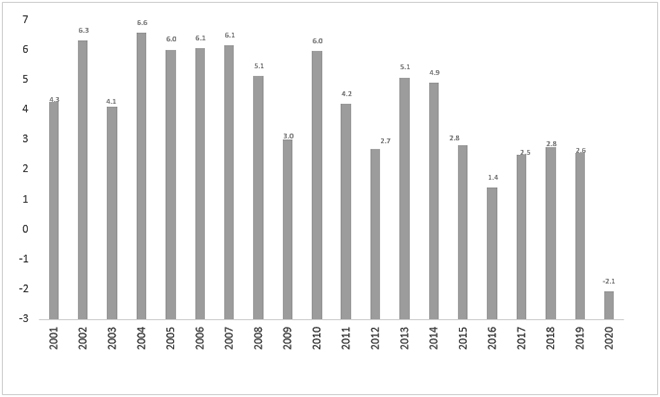
Source: World Bank Data[4]
After a protracted period of improvement between 2000 and 2013, hunger has significantly worsened in Africa, with most of this deterioration occurring between 2019 and 2020 (see Figure 2). According to The State of Food Security and Nutrition in the World 2022 report, 828 million people—or one in every nine individuals—experienced hunger in 2021.[5] This is 150 million more people than in 2019 and 46 million more than in 2020.[6] Of the 828 million, 35 percent, or 289.1 million undernourished people, live in extreme poverty in Africa.[7] In 2020, Africa had the most stunted[a] children globally (61.4 million), up from 54.4 million in 2000.[8]
Figure 2: The prevalence of undernourishment in Africa (2000 to 2021)
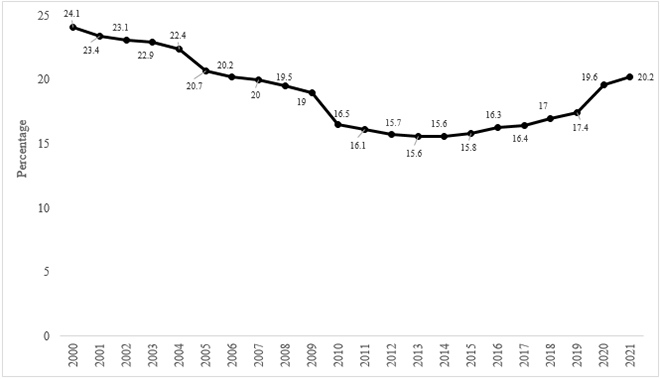
Source: FAOSTAT Data[9]
While global food insecurity is now at an all-time high, Africa's record in addressing undernutrition was not impressive even in the pre-pandemic era when growth rates were higher. Africa failed to meet the Millennium Development Goal of reducing hunger, and, in 2017, was far from achieving goal 2 (zero hunger) of the Sustainable Development Goals (SDGs).[10] A main cause of this rise in hunger is the re-emergence of famines; in 2017, a famine was declared in some parts of South Sudan, while Somalia and northeastern Nigeria were on the brink of famine.[11] Severe droughts and protracted conflicts led to a sharp increase in acute malnutrition rates and the number of people suffering from hunger in these countries.
The incidence of undernourishment is significantly higher in Sub-Saharan Africa than other regions of the world—countries like Somalia (53.1 percent), Central African Republic (52.2 percent), Madagascar (48.5 percent), Democratic Republic of Congo (39.8 percent), and Chad (32.7 percent) have exceptionally high levels of undernourishment (see Figure 3).
Figure 3: Prevalence of Undernourishment
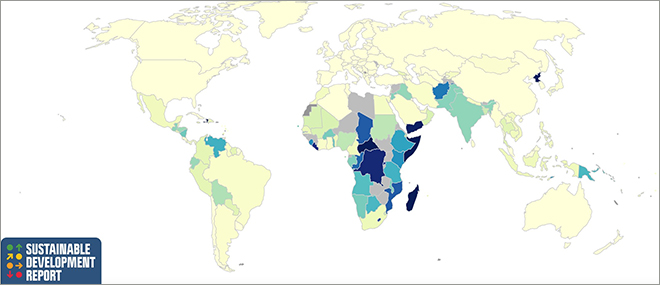
Source: Sustainable Development Report 2023[12]
Note: Darker areas indicate higher undernourishment
Children in Sub-Saharan African are also highly affected by stunting and wasting (see Figure 4 and Figure 5). Over 40 percent of children below five years of age are stunted in countries like Libya (52.2 percent), Eritrea (50.2 percent), Niger (47.4 percent), Angola (43.6 percent), and Democratic Republic of Congo (40.3 percent). In 2022, the percentage of severely wasted children was highest in South Sudan (22.7 percent), Sudan (16.3 percent), Mauritania (13.6 percent), and Somalia (14.3 percent).
Figure 4: Prevalence of stunting in children under five years of age (in percentage)
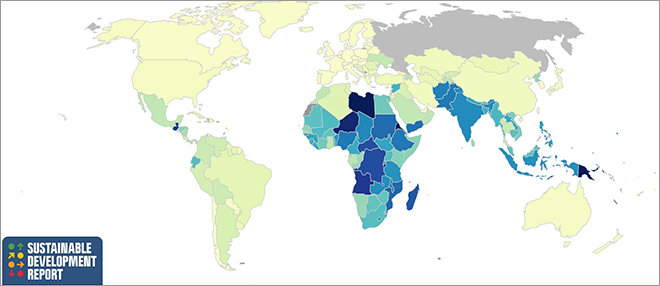
Source: Sustainable Development Report 2023[13],
Note: Darker areas indicate a higher prevalence of stunting
Figure 5: Prevalence of wasting in children under five years of age (in percentage)
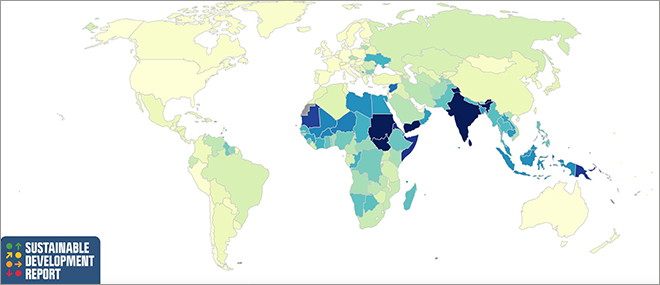
Source: Sustainable Development Report 2023[14]
Note: Darker areas indicate a higher prevalence of wasting
Africa's current food insecurity should not be seen as a short-term problem but as a consistent problem that requires substantial policy actions (as discussed later in this paper). Africa is not on track to reach the SDGs' food security and nutrition targets due to the high prevalence of malnutrition, high levels of food insecurity, and an increase in the number of poor. This has been compounded by a negative supply shock due to the ongoing war between Ukraine and Russia. Consequently, a 'vicious cycle' has emerged that threatens food security and economic stability (see Figure 6) and could further trigger social unrest in Africa.
Figure 6: Vicious cycle of rising prices
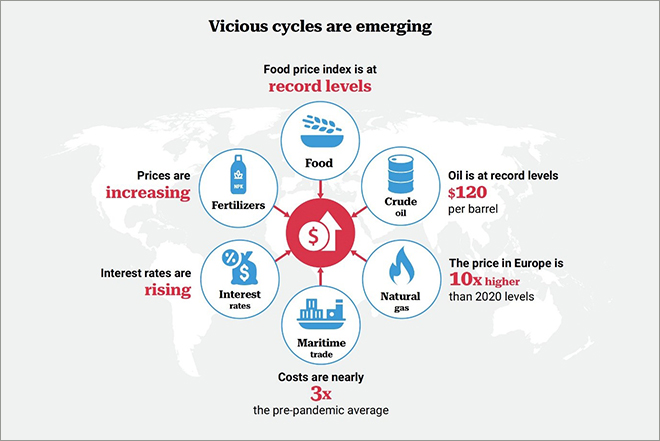
Source: 2022 Africa Sustainable Development Report[15]
Food Security in Africa: The Main Challenges
There are several causes for heightened hunger levels in Africa, both short- and long-term, such as the pandemic, the ongoing Ukraine-Russia war, climate change, and low agricultural productivity and policy issues.
COVID-19 pandemic
Sub-Saharan Africa was one of the most food insecure regions globally, even before the onset of the COVID-19 pandemic and its subsequent impacts on the economy and other key areas of development. According to the 2020 Global Report on Food Crises, over half of the world's 135 million people who faced food insecurity in 2019 lived in Sub-Saharan Africa (73 million people), and 2020 was the most severe year for food crises.[16] The pandemic has significantly impacted food security in Africa, exacerbating an existing problem.[17] Disruptions in food supply chains due to the pandemic led to shortages and higher prices of essential food items. The closure of borders and lockdowns further hindered the movement of goods and people, causing difficulties in harvesting, processing, and transporting food. Economic disruptions, job losses, and reduced incomes made it harder for people to afford food.[18] The pandemic also caused reduced agricultural production in Africa due to disruptions in supply chains, curbed access to inputs such as seeds and fertilisers, and resulted in labour shortages. This led to decreased food availability and higher food prices.[19] These factors increased food insecurity in Africa, with millions of people at risk of hunger and malnutrition.[20] Indeed, the UN had warned that the pandemic could cause up to 132 million more people to suffer from hunger in 2020.[21] The disruption of food aid programmes also made it harder to get food to people in need. Travel restrictions, border closures, and reduced funding for aid programmes further exacerbated the issue.
Conflict
Ukraine-Russia war: The Ukraine-Russia war has had far-reaching consequences for global food security, especially for Africa because many African countries heavily depend on food and fertiliser imports from Russia and Ukraine. Over 20 African countries import 90 percent of their wheat from Russia and Ukraine.[22] The war led to a 60-percent rise in the price of wheat in Africa in 2022 and, as per the African Development Bank, the continent was expected to lose food worth US$11 billion due to supply chain disruptions due to the war.[23] As the war continues, food prices in Africa remain elevated.[24]
Russia is the largest exporter of fertilisers and, together with Belarus (the second largest), accounts for 17 percent of global exports. Western sanctions on Russia have also led to a shortage of and a rise in the prices of fertilisers, which will have a knock-on effect on agricultural production.[25] As a result, most African farmers are no longer using fertilisers, which will lead to lower yields in the coming agricultural seasons. Since sanctions have also resulted in a decline in the export of Russian fertilisers to other countries, global food production is also likely to be affected in the coming seasons. A negative consequence of the fertiliser trade restrictions will be lower rice production in Asia, contributing to a further rise in food prices and lower food availability in the future.
The pandemic shock followed by the Ukraine-Russia war resulted in a -2.7 percent impact on labour productivity in Africa's agricultural sector in 2022 while also causing a 0.8 percent fall in overall agricultural labour productivity (see Table 1). Guinea, Mali, and Tunisia saw the most significant declines in agricultural labour productivity, followed by Egypt and the Democratic Republic of Congo.
The decrease in agricultural productivity in Africa has led to a slowdown in achieving SDG-2. GDP growth and overall productivity declined in all 16 countries (for which data is available) in 2022, while unemployment increased. This is certain to impact household access to food across Africa.
Table 1: Production per unit of Labour-Agricultural Productivity in Africa in 2022
| Countries |
BAU Value |
Change due to COVID-19 + Russia-Ukraine war compared to BAU (in %) |
Change due to Russia-Ukraine war compared to BAU (in %) |
| Nigeria |
3.7 |
-1.6 |
-0.9 |
| South Africa |
4.0 |
3.0 |
0.3 |
| Egypt |
3.0 |
-2.8 |
-1.1 |
| Malawi |
5.5 |
-4.9 |
-0.3 |
| Democratic Republic of Congo |
3.7 |
-0.8 |
-1.1 |
| Guinea |
1.7 |
-22.3 |
-1.3 |
| Mozambique |
1.7 |
4.6 |
0.2 |
| Senegal |
4.1 |
-6.8 |
1.9 |
| Tunisia |
5.0 |
-11.9 |
-1.5 |
| Uganda |
10.5 |
-3.8 |
-2.1 |
| Ethiopia |
2.0 |
-2.6 |
-0.8 |
| Tanzania |
3.0 |
-1.1 |
-0.4 |
| Mali |
4.0 |
-13.8 |
-0.5 |
| Kenya |
2.6 |
-1.2 |
-0.5 |
| Ghana |
3.3 |
6.3 |
0.7 |
| Niger |
5.0 |
-6.9 |
0.3 |
| All |
3.0 |
-2.7 |
-0.8 |
Source: 2022 Africa Sustainable Development Report[26]
Note:
- BAU = Business as Usual
- Disaggregated data is available only for the countries listed here.
Conflict-induced famines: Conflicts and conflict-induced famines have significantly aggravated food insecurity in many African countries, particularly those in the Horn of Africa. By the 1980s, episodes of mass starvation had declined, and the number of famine-related deaths globally had also reduced.[27] In 2017, a famine was declared in parts of South Sudan, while Somalia and northeastern Nigeria experienced crisis-level food insecurity, primarily due to conflicts (a civil war in South Sudan, the Boko Haram insurgency in Nigeria, and fighting between Al-Shabab fighters and government forces in Somalia).[28],[29],[30]
Indeed, about 80 percent of the 137 million Africans suffering from acute food insecurity[b] live in eight conflict-ridden countries—the Democratic Republic of Congo, Ethiopia, Nigeria, Sudan, South Sudan, Somalia, Niger, and Burkina Faso.[31]
A significant body of literature explores the causal links between conflicts and famines. Economist Amartya Sen asserted that "entitlement failures"[c] caused famines rather than a food shortage. He stressed the role of democracies, where the state actively protected the entitlements of the people while wars and conflicts destroyed people's entitlements.[32] As per Sen, "The most pernicious effect of war and war-like situations is a weakening of the opportunity of adversarial politics and social criticism".[33] While Sen has stressed the role of the democratic state in preventing famines, anthropologist Alex de Waal and political scientist Jenny Edkins argue that it is more important to delve into the question of "who caused the famine" because modern-day famines are often deliberate strategies used by armed forces to weaken their opponents and starve the population.[34] Further, they assert that, in conflict-stricken countries, the state often aggravates the food crisis rather than alleviating it by being a democratic welfare state.[35],[36] This is particularly true in many African countries like South Sudan and Ethiopia, where the state has often been found to underplay the food crisis and aggravate it by misusing humanitarian relief and using hunger as a weapon of war.[37]
The works of Amrita Rangasami, Mamdou Baro, and Tara F Deubel are also important in understanding Africa's recurrent famines. They argue that famines are not sudden collapses into starvation but a recurring phenomenon in some regions that are mired by abject poverty and poor capacity to absorb shocks. This is particularly true for African countries like South Sudan and the Democratic Republic of Congo, which are experiencing protracted conflict. Conflicts destroy livelihoods, economic activity, roads, and transport systems and damage the social fabric of the population. Additionally, aid efforts are hampered by conflict as armed groups often prevent the flow of humanitarian aid to those in need.
Climate change
Despite accounting for less than 4 percent of global greenhouse gas emissions, African countries are at the centre of the climate crisis.[38] According to the Intergovernmental Panel on Climate Change (IPCC), temperatures in Africa are predicted to rise faster than the global average. African countries within 15 degrees of the equator are expected to endure more frequent heat waves and hot nights.[39] The western Sahel region will experience the strongest drying, western and central Africa will witness large increases in the number of hot days at both 1.5°C and 2°C, and southern Africa will experience a 20-percent decline in precipitation at 2°C.[40] Africa will be the most severely affected region not only because the expected degree of climate change is the largest but also because the adaptive capacity of its population is extremely low on account of endemic poverty, poor governance, absence of institutions, population growth, high dependence on rain-fed agriculture and livestock, and conflict.[41] Five African countries—Chad, the Central African Republic, Guinea Bissau, Eritrea, and the Democratic Republic of Congo—are the most vulnerable to the impacts of climate change, according to the ND-GAIN Country Index.[d],[42]
As such, climate change is a major long-term challenge to African food security and affects all aspects of food security—production, access, absorption, and stability.[43] Extreme climate events such as droughts, floods, and storms that devastate crop production and affect transport systems have increased tenfold in Africa since the 1970s.[44] Nearly one-third of the world's worst droughts occur in Sub-Saharan Africa, with Kenya and Ethiopia (which is also battling conflict) witnessing one of the severest droughts in the last four decades, and Angola is undergoing its fifth consecutive drought year.[45] The Horn of Africa also suffers from persistent droughts. The ongoing drought, the worst in four decades, has led to a dramatic increase in hunger in the region, with a 60-percent increase in the number of hungry people, from 51 million in 2021 to 82 million in 2022.[46]
Climate change has significantly impacted productivity and crop yields in Africa. According to the IPCC's sixth assessment report, agricultural productivity growth has declined by 34 percent since 1961 due to climate change.[47] Wheat and maise yields declined by 2.3 percent and 5.8 percent between 1974 and 2008 due to climate change. Crop production is estimated to be between 58 percent and 70 percent lower than the long-term average in highly food-insecure countries and regions like Somalia and southeastern Kenya.[48] Global warming above 2°C is likely to lead to yield reductions for almost all staple crops across Africa compared to 2005 levels even when considering the positive impacts of higher CO2 concentration[e] and adaptation options. Further, the IPCC report projects a decline in yields for crops like sorghum and olives in case of a 1.5°C temperature increase.[49]
Severe drought conditions have also resulted in more than 1.5 million cattle deaths in the region.[50] Countries such as Chad are also adversely affected by torrential rains and floods, and such extreme events significantly impact food production in Africa because agricultural productivity is already very low in these countries. According to a 2022 report by the International Monetary Fund, each drought or flood increases food insecurity by between 5 percent to 20 percent in countries like Mali, Niger, Tanzania, Malawi, and Ethiopia.[51] A warming of 1.2°C to 1.9°C is likely to increase the incidence of undernutrition by 25 percent in central Africa, 50 percent in East Africa, 85 percent in southern Africa, and 95 percent in West Africa.[52]
Another threat to African food production is water stress caused by climate change. This will be particularly challenging for most African countries as they are heavily dependent on rain-fed agriculture and less than 1 percent of the total agricultural land is irrigated on the continent.[53] By 2040, Africa will experience total deglaciation,[f] although Mount Kenya is likely to experience deglaciation even sooner (by the 2030s).[54] By 2030, roughly 700 million fewer people will likely live in Africa due to high water stress.[55] Drought and changing precipitation patterns also affect important water bodies like Lake Chad, which has shrunk nearly 90 percent since the 1960s, and Lake Victoria, which is heavily dependent on precipitation and fluctuates significantly during El Niño (wet) and La Niña (dry) years.[56] The four rainy seasons[g] between October 2020 and May 2022 were marked by poor rainfall and, as a consequence, large parts of Ethiopia, Kenya, and Somalia are facing the most prolonged drought in recent history.[57]
Rising temperatures and water levels due to climate change are also causing insects and weed seeds to migrate to Sub-Saharan Africa. In 2019-20, locust infestation affected 1.25 million hectares of land in Kenya, Somalia, and Ethiopia, and the consequent infestation response increased the region's financing needs by US$70 million.[58]
Climate change will also likely lead to a shortage of protein-rich foods like fish, meat, and dairy products through diminished fishing yields, animal lifespans, and livestock grazing areas. Estimates suggest that by 2050, fish production in coastal West Africa and Lake Tanganyika will decline by 21 percent and 30 percent, respectively, with adverse consequences across East African countries like Tanzania, Zambia, and Burundi.[59]
In addition, to the impact on food production, climate change also has adverse consequences on other aspects of food security[60]:
- Food access: Climate change can impact food access by disrupting food systems, reducing food availability, and increasing food prices. This can be due to extreme weather events such as floods or droughts, which can destroy crops and disrupt supply chains. This can make it difficult for people to access the food they need to maintain a healthy and balanced diet.
- Food absorption: Climate change can also impact the absorption of nutrients from food. For example, rising temperatures and changing rainfall patterns can reduce crop yields and lower nutrient content in crops, particularly in staple crops like maise and wheat. This can lead to a decline in the availability of key nutrients such as iron, zinc, and vitamin A, which are essential for maintaining good health.[61]
- Food stability: Climate change can also impact food stability, which refers to the ability of food systems to withstand and recover from shocks such as droughts, floods, or economic downturns. Climate change can make food systems more vulnerable to these shocks, particularly in regions with limited infrastructure and resources. This can lead to food shortages and price volatility, exacerbating food insecurity.
It is crucial to adopt a comprehensive approach that includes both adaptation and mitigation strategies to address these challenges.[62] Adaptation strategies can help to build resilience in food systems and reduce vulnerability to climate change impacts. Mitigation strategies can help to reduce greenhouse gas emissions and limit the extent of future climate change impacts. By implementing these strategies, African countries can work towards ensuring that their food systems can provide adequate and nutritious food for all their citizens, despite the challenges posed by climate change.
Low agricultural productivity
Although many African countries experienced high economic growth rates in the last two decades, the commodities sector was primarily responsible for this growth while agriculture was neglected. Agricultural productivity in Africa continues to be among the lowest in the world. Increasing agricultural productivity in Africa will likely greatly enhance the region's ability to address food insecurity.[63]
Labour productivity[h] in agriculture is very low in Africa. Value added per worker in Sub-Saharan Africa (US$1,525.9) is less than half the global average (US$4,035.3) and more than 50 times lower than developed countries like the US (US$100,061.6), UK (US$55,829.4), Germany (US$43,714.5) and Australia (US$86,838.2).[64] Similarly, cereal yield[i] in Sub-Saharan Africa (1.6 t/ha) is significantly lower than the global average (4.07 t/ha) and yields in other regions.[j],[65]
Low priority to food security
Several studies trace Africa's current food insecurity to the colonial pattern of agriculture that emphasised the cultivation of export commodities like coffee and cocoa rather than food crops for domestic consumption.[66] Unlike other developing regions, overall agricultural production in Sub-Saharan Africa has been on the decline even after most African countries gained independence.[67] This is because, even after independence, most African governments failed to support the agriculture sector due to a lack of political will, strict conditionality of structural adjustment policies, and adverse conditions in international trade in agricultural products.
Much has changed in Africa in recent years, and food security emerged as a major policy goal with the adoption of the Comprehensive Africa Agriculture Development Programme in 2003. Agenda 2063,[k] Africa's master plan for transforming the continent into a global powerhouse, also aims to eliminate hunger and food insecurity through improved productivity levels and agro-business development. However, this has not yet resulted in any actual investments in agriculture. Given the rapidly growing population and vulnerability to climate change, African governments should urgently expand investments in agriculture to improve their productivity. However, their mounting debt burdens impair their ability to do so.
Overcoming the Challenge of Food Insecurity
The various causes for Africa's food insecurity are not independent. The intersection of climate change with conflict, poor governance, lack of institutions, and low investment in climate-resilient agriculture has made Africa's poorer and drier regions extremely vulnerable to food insecurity. Therefore, the continent needs short- and long-term solutions to address this issue. These can include:
- Investing in agricultural development: Agriculture is a key driver of economic growth in Africa, and investing in agricultural development can increase food production and reduce poverty. This can be achieved by improving access to inputs such as seeds, fertilisers, and water and building better infrastructure for storage, transportation, and marketing.
- Promoting sustainable farming practices: Sustainable farming practices, such as conservation agriculture and agroforestry, can increase crop yields and reduce environmental degradation. This includes reducing soil erosion, using natural pest control methods, and improving soil health through crop rotation and organic matter.
- Increasing access to financial services: Many smallholder farmers in Africa lack access to credit and financial services, which limits their ability to invest in their farms. Increasing access to financial services can help farmers access the capital they need to improve their productivity and income.
- Improving nutrition and health: Improving nutrition and health can help reduce the prevalence of malnutrition and improve the overall well-being of communities. This can be done through initiatives such as fortifying staple foods with essential micronutrients, promoting breastfeeding, and improving access to clean water and sanitation.
- Addressing conflict and instability: Conflict and instability can exacerbate food insecurity by disrupting food production and distribution. Addressing conflict and instability in Africa through consistent efforts in peacebuilding is crucial to improving food security in the region.
- Increase in agricultural aid to Africa: The agricultural sector in most African countries face multiple challenges—climate change, water shortages, low productivity, land degradation, poor investments, and a burgeoning population with growing food demands. For several of these countries, international aid is an essential source of financing for the agricultural sector. However, agriculture is no longer a priority area for donors, and the share of international aid to the sector has declined consistently since the 1980s and stood at about 3.8 percent in 2020.[68] Economists John W. McArthur and Jeffrey D. Sachs find that targeted official development assistance to agriculture will expand the primary tradable sector and positive welfare and productivity effects, while reducing the need for official development assistance for budgetary support.[69] Therefore, increasing the share of international aid to agriculture is the need of the hour.
To meet the commitments made in the Malabo Declaration, which aims to halve poverty and end hunger on the African continent by 2025, Africa needs a comprehensive strategy on nutrition and programmatic action.[70] According to estimates for Africa, every dollar spent on preventing childhood undernourishment can generate a return of US$16.[71] Rwanda's multisector public-private partnership approach to combat malnutrition is a notable successful strategy in Africa.[72] Rwanda delivers nutritious, locally-sourced meals to mothers who are expecting or nursing babies and malnourished youngsters. The government also promotes kitchen gardens to broaden dietary options and boost meal frequency.[73] This policy initiative has improved the nutritional status of families and children. Case studies from India show that nutrition gardens can lower incidences of malnutrition in children and families while empowering women and enhancing their means of subsistence.[74],[75] Investing in nutrition-specific and nutrition-sensitive initiatives is essential to prevent malnutrition and promote nutrition resilience. African government and other decision-makers should place the highest focus on addressing all types of malnutrition. To supplement nutrition interventions in the fight against malnutrition, investing in initiatives across sectors like agriculture, sanitation, health, and education is crucial.
Africa must concentrate on transforming agriculture through increased productivity; African countries' reliance on grain imports will decrease with higher agricultural production, providing food security. This can be accomplished by investing in irrigation, mechanisation, research and development, access to fertilisers, and lower transaction costs that are also environmentally benign. External shocks will likely continue to affect the developing industrial sector, primarily through rising energy prices. Therefore, policymakers must make significant investments to provide fair and accessible access to energy to sustain this sector. African countries must also create social protection systems to shield vulnerable and underprivileged households from the damaging consequences of international crises.
The G20's Potential Role
The G20 countries represent around 85 percent of the global GDP, over 75 percent of global trade, and about two-thirds of the world population, and substantially influence the governance of major international issues.[76] As such, the G20 is the perfect platform to initiate a global response to address Africa's food security concerns. Although experts have often lamented that the G20 does not adequately represent Africa, initiatives to discuss African affairs at the forum began in 2010 under the Korean presidency with the endorsement of the Seoul Development Consensus.[l] However, the most important G20 initiative is the 2017 'Compact with Africa' (CwA), which was propelled by the refugee crisis in Europe and China's growing influence in Africa.[77] The CwA sought to bring together reform-minded African countries, G20 countries, and international organisations (such as the African Development Bank, World Bank, and International Monetary Fund) to coordinate country-specific reform agendas, support policy actions, and attract private sector finance. Although the CwA initiative was open to all African countries, only 12 states have joined the initiative (Benin, Burkina Faso, Côte d'Ivoire, Egypt, Ethiopia, Ghana, Guinea, Morocco, Rwanda, Senegal, Tunisia, and Togo). While most compact countries have improved their Ease of Doing Business rankings and undertaken reform measures, these efforts have not translated into adequate investments.[78] According to the CwA Monitoring Report 2022, foreign investor appetite is mainly concentrated in extractive industries like coal, gas, and oil and sustainable infrastructure,[79] with fewer agricultural investments.
India has often stated that Africa is among its top foreign policy priorities, and the country has always supported African representation in multilateral organisations.[80] To avoid losing the momentum of its drive to strengthen ties with Africa, India should try to carve a niche for Africa-centric themes at the G20.[81] Given Africa's massive challenges related to food security, India should use its presidency to push for a global response to address Africa's chronic food insecurity. It is impossible to achieve the SDGs unless they are also met in Africa. A stable and food-secure Africa is in the global interest. Europe, in particular, has a special interest in African stability to ward off spill-over effects from armed conflicts, climate change, hunger, and forced migration.[82] Therefore, a G20 initiative to address African food security is needed.
A G20 special financial package for Africa's food insecurity
India should announce a special package to address Africa's food insecurity and make a substantial initial contribution. The leading causes of Africa's food insecurity are interlinked. Therefore, the G20 special package should support concrete long-term and short-term policy actions to make Africa food secure. Funds should be channelled to international agencies like the Food and Agriculture Organisation, African Development Bank, International Fund for Agricultural Development, and the World Food Programme to enhance Africa's food security and provide humanitarian assistance to African countries in need. Substantial resources should be devoted to addressing the chronic problems of low agricultural productivity and the endemic climate vulnerability of African agriculture. The permanent solution to Africa's chronic food insecurity lies in boosting Africa's domestic food production and reducing its reliance on food imports and aid.
Conclusion
Africa's current crisis highlights the importance of prioritising food security in public policy. The continent's chronic food insecurity is a complex issue requiring coordinated and sustained effort from governments, international organisations, and other stakeholders. As a group of the world's largest economies, the G20 is critical in addressing this issue. Overcoming food insecurity in Africa requires a multifaceted approach that involves improving agricultural productivity, promoting sustainable farming practices, encouraging private sector investment, increasing access to financial services, improving nutrition and health, increasing aid to agriculture, and addressing conflict and instability. By implementing these strategies, African countries can work towards ensuring that all their citizens have access to adequate and nutritious food. This paper recommends a special financial package for Africa to address the continent's food security challenges.
Endnotes
[a] Low height for age.
[b] Acute food insecurity refers to a situation when a person’s inability to consume adequate food puts their lives or livelihoods in immediate danger. This equates to a risk category of 3 or higher (crisis, emergency, and famine) on the Integrated Food Security Phase Classification scale of 1 to 5.
[c] Entitlements are the set of commodity bundles over which a household can establish operative control.
[d] The ND-GAIN Country Index, published by the University of Notre Dame, summarises a country's vulnerability to climate change and other global challenges in combination with its readiness to improve resilience.
[e] Under elevated CO2, most plant species show higher rates of photosynthesis, increased growth, decreased water use, and lowered tissue concentrations of nitrogen and protein.
[f] Deglaciation is the disappearance of ice from a previously glaciated region.
[g] The four rainy seasons are October-December 2020, March-May 2021, October-December 2021, and March-May 2022
[h] Value added per worker is the measure of labour productivity.
[i] Cereal yield i.e., tonnes of cereal produced per hectare of land is a measure of land productivity. Cereals include wheat, rice, maize, barley, oats, rye, millet, sorghum, buckwheat, and mixed grains.
[j] North America (7.23 t/ha), East Asia (6.2 t/ha), Northern Europe (5.6 t/ha), and Central America (3.5 t/ha)
[k] The Agenda 2063 was adopted by the African Union at the summit in January 2015 and promulgated in February 2015.
[l] The Seoul Development Consensus is a set of guidelines adopted at the 2010 Seoul Summit to help the G20 countries work with less developed economies to boost their growth and achieve the Millennium Development Goals.
[1] “Africa Rising”, The Economist, December 3, 2011.
[2] McKinsey&Company, Lions on the move: The progress and potential of African economies, June 2010, McKinsey Global Institute, 2010.
[3] United Nations, Trade and Development Report 2022: Development prospects in a fractured world – Global disorder and regional responses, Geneva, United Nations, 2023.
[4] World Bank Database.
[5] FAO, The State of Food Security and Nutrition in the World 2022: Repurposing food and agricultural policies to make healthy diets more affordable, Rome, FAO, 2022.
[6] “The State of Food Security and Nutrition in the World 2022: Repurposing food and agricultural policies to make healthy diets more affordable, 2022”
[7] “The State of Food Security and Nutrition in the World 2022: Repurposing food and agricultural policies to make healthy diets more affordable, 2022”
[8] “The State of Food Security and Nutrition in the World 2022: Repurposing food and agricultural policies to make healthy diets more affordable, 2022”
[9] FAOSTAT Database.
[10] Malancha Chakrabarty, “Africa is rising but so is hunger”, Observer Research Foundation.
[11] Malancha Chakrabarty, “A Giant Leap Backwards: Is the Zero Hunger Goal Achievable”, World Affairs: The Journal of International Issues 22, no. 4 (Winter 2018): 136
[12] Sustainable Development Report 2023.
[13] Sustainable Development Report 2023
[14] Sustainable Development Report 2023
[15] 2022 Africa Sustainable Development Report.
[16] Food Security Information Network, 2020 Global Report on Food Crises, 2020.
[17] United Nations, Policy Brief: The impact of Covid-19 on Food security and Nutrition, 2020.
[18] “COVID-19 and Africa: Socio-economic implications and policy responses”, OECD, May 7, 2020.
[19] Helen Onyeaka, et al., "Food insecurity and outcomes during COVID-19 pandemic in sub-Saharan Africa (SSA)," Agriculture & Food Security 11, no. 1 (2022): 1-12.
[20] Carolina Sanchez Paramo, “Covid-19 will hit the poor hardest-what can we about it”, World Bank Blog, April 23, 2020.
[21] “UN report: Pandemic year marked by spike in world hunger”, July 12, 2021.
[22] “How the Ukraine Invasion Impacts Food Security in Africa”, Agrilinks, July 27, 2022.
[23] James Tasamba, “Wheat prices in Africa up 60% due to Russia-Ukraine war: AfDB”, Anadolu Agency, April 27, 2022.
[24] World Bank, Food Security Update, June 2023, The World Bank Group, 2023.
[25] Vamo Soko and Bintu Zahara Sakor, “The Ukraine Crisis and Its Impact on Africa’s Geopolitics: What Do We Know So Far?”, Peace Research Institute Oslo.
[26] 2022 Africa Sustainable Development Report
[27] “Famine Trends Dataset, Tables and Graphs”, World Peace Foundation.
[28] “Famine hits parts of South Sudan”, UNICEF, February 20, 2017.
[29] “Famine Prevention: Nigeria, Somalia, and South Sudan Country Updates”, UNHCR.
[30] ACAPS, Famine: Northeast Nigeria, Somalia, South Sudan, and Yemen, May 2017.
[31] “Conflict Remains the Dominant Driver of Africa’s Spiraling Food Crisis”, Africa Center for Strategic Studies, October 14, 2022.
[32] Amartya Sen, “Wars and Famines: On Divisions and Incentives”, Peace Economics, Peace Science and Public Policy 6, no.2 (Spring 2000): 10
[33] Sen, “War and Famines: On Divisions and Incentives”
[34] Alex de Waal, “The Nazis Used It, We Use It: Alex de Waal on the Return of Famine as a Weapon of War”, London Review of Books 39, no. 12 (2017).
[35] de Waal, “The Nazis Used It, We Use It: Alex de Waal on the Return of Famine as a Weapon of War”
[36] Jenny Edkins, “Mass Starvations and the Limitations of Famine Theorising”, IDS Bulletin 33, no. 4 (2002): 12
[37] Malancha Chakrabarty, “The Enduring Link Between Conflict and Hunger in the 21st Century”, ORF Issue Brief No. 500, October 2021.
[38] Elliot Carleton, “Climate change in Africa: What will it mean for agriculture and food security?”, International Livestock Research Institute, February 28, 2022.
[39] Dan Shepard, “Global warming: severe consequences for Africa”, Africa Renewal, December 2018 - March 2019.
[40] Shepard, “Global warming: severe consequences for Africa”
[41] Richard Washington, “How Africa will be affected by climate change”, BBC News, December 15, 2019.
[42] University of Notre Dame.
[43] Malancha Chakrabarty, “Climate change and food security in India”, In Ruchita Beri
Anjoo Sharan Upadhyaya, Åshild Kolås (Eds.) Food Governance in India - Rights, Security and Challenges in the Global Sphere, Routledge (London: 2022)
[44] “How Global Warming Threatens Human Security in Africa”, Africa Centre for Strategic Studies, October 29, 2021.
[45] Laurent Kemo at al. “How Africa can escape chronic food insecurity amid climate change”, Africa Renewal, September 14, 2022.
[46] “‘We cannot give up’ on the millions suffering in drought-stricken Horn of Africa, urges WFP official”, United Nations News, November 28, 2022.
[47] Christopher H. Triso, Ibidun O. Adelekan and Edmond Totin, Africa In Climate Change 2022: Impacts, Adaptation and Vulnerability, Contribution of Working Group II to the Sixth Assessment Report of the Intergovernmental Panel on Climate Change eds. (HO Pörtner, DC Roberts, M Tignor, ES Poloczanska, K Mintenbeck, A Alegría, M Craig, S Langsdorf, S Löschke, V Möller, A Okem, B Rama), Cambridge University Press, Cambridge, UK and New York, NY, USA, pp. 1285–1455.
[48] “Drought crisis puts Horn of Africa ‘on the brink of catastrophe’”, Aljazeera, February 15, 2022.
[49] “Africa”
[50] “Drought crisis puts Horn of Africa ‘on the brink of catastrophe’”, Aljazeera, February 15, 2022.
[51] Baptista et al., “Climate Change and Chronic Food Insecurity in Sub-Saharan Africa”, International Monetary Fund, September 2022
[52] Carleton, “Climate change in Africa: What will it mean for agriculture and food security?”
[53] Baptista et al., “Climate Change and Chronic Food Insecurity in Sub-Saharan Africa”
[54] “How Global Warming Threatens Human Security in Africa”, Africa Centre for Strategic Studies
[55] “WMO: Climate change in Africa can destabilize ‘countries and entire regions’”, UN News, September 8, 2022, https://news.un.org/en/story/2022/09/1126221
[56] Claire Ransom, “From droughts to loss of glaciers: Here's the state of African climate ahead of COP27”, World Economic Forum, November 3, 2022, https://www.weforum.org/agenda/2022/11/water-worries-the-state-of-the-african-climate-ahead-of-cop27/
[57] Erik English, “New Roots of Famine: How climate crises and global conflict combine to threaten millions in the Horn of Africa”, Bulletin of the Atomic Scientists, August 18, 2022, https://thebulletin.org/2022/08/how-climate-crises-and-global-conflict-combine-to-threaten-millions-in-the-horn-of-afrca/
[58] Baptista et al., “Climate Change and Chronic Food Insecurity in Sub-Saharan Africa”
[59] Baptista et al., “Climate Change and Chronic Food Insecurity in Sub-Saharan Africa”
[60] FAO, Climate Change and Food Security: risks and responses, FAO, 2015, https://www.fao.org/3/i5188e/I5188E.pdf
[61] Baptista et al., “Climate Change and Chronic Food Insecurity in Sub-Saharan Africa”
[62] Denton, F et al., “Climate-resilient pathways: adaptation, mitigation, and sustainable development”, in Climate Change 2014: Impacts, Adaptation, and Vulnerability. Part A: Global and Sectoral Aspects. Contribution of Working Group II to the Fifth Assessment Report of the Intergovernmental Panel on Climate Change, ed. Field, CB et al. (Cambridge and New York: Cambridge University Press, 2014), 1101-31, https://www.ipcc.ch/site/assets/uploads/2018/02/WGIIAR5-Chap20_FINAL.pdf
[63] “Increasing Agricultural Productivity Critical to Food Security in Sub-Saharan Africa”, Reliefweb, November 1, 2011, https://reliefweb.int/report/world/increasing-agricultural-productivity-critical-food-security-sub-saharan-africa?gclid=Cj0KCQiAx6ugBhCcARIsAGNmMbjOIN8HoBk7NdV6u6ettIah0wDUrsp-Im3gCsx-0R0BZHoE7MV3lkwaAn2hEALw_wcB
[64] Hannah Ritchie, “Increasing agricultural productivity across Sub-Saharan Africa is one of the most important problems this century”, Our World in Data, April 4, 2022, https://ourworldindata.org/africa-yields-problem
[65] Ritchie, “Increasing agricultural productivity across Sub-Saharan Africa is one of the most important problems this century”
[66] Sam Moyo, “Agrarian Transformation in Africa and its Decolonisation”, in Agricultural Development and Food Security in Africa, 42. Ed. Fantu Cheru et al. (London: Zed Books, 2013)
[67] Vibeke Bjornlunda, Henning Bjornlunda and Andre F. Van Rooye, “Why agricultural production in sub-Saharan Africa remain slow compared to the rest of the world–a historical perspective”, International Journal of Water Resources Development 36, no. S1 (2020), https://www.tandfonline.com/doi/full/10.1080/07900627.2020.1739512#:~:text=Agricultural%20production%20in%20sub%2DSaharan%20Africa%20has%2C%20in%20recent%20times,soil%20quality%2C%20slavery%20and%20disease.
[68] “Official international assistance: Stagnation despite pledges and new development challenges”, SDG Pulse, https://sdgpulse.unctad.org/official-support-development/
[69] John W. McArthur and Jeffrey D. Sachs, “Agriculture, Aid and Economic Growth in Africa”, Policy Research Working Paper 8447, World Bank, April 2018, https://openknowledge.worldbank.org/server/api/core/bitstreams/9b2c3987-cba8-5063-bd3d-23a24a71cf62/content
[70] “Malabo Declaration on Accelerated Agricultural Growth and Transformation for Shared Prosperity and Improved Livelihoods”, https://au.int/sites/default/files/documents/31247-doc-malabo_declaration_2014_11_26.pdf
[71] Hoddinott, John, "The economics of reducing malnutrition in sub-Saharan Africa." Global Panel on Agriculture and Food Systems for Nutrition Working Paper 21 (2016).
[72] Africa-Improved Foods, ‘Nutrition’, https://africaimprovedfoods.com/nutrition-2/
[73] Vibha Varshney, ‘How a nutrition programme is helping a rwanda village overcome malnutrition’, Down To Earth, December 10, 2018, https://www.downtoearth.org.in/news/health-in-africa/how-a-nutrition-programme-is-helping-a-rwanda-village-overcome-malnutrition-62437
[74] Shoba Suri, “Nutrition Gardens: A Sustainable Model for Food Security and Diversity,” ORF Issue Brief No. 369, June 2020, Observer Research Foundation, https://www.orfonline.org/research/nutrition-gardens-a-sustainable-model-for-food-security-and-diversity-67933/
[75] Parida, Prashant K., et al., "Nutrition Sensitive Annadata Kitchen Garden Model: Growth for health and wellbeing of tribal poor–A couple of case studies." Current Research in Nutrition and Food Science 6, no. 3 (2018): 882., http://www.foodandnutritionjournal.org/volume6number3/nutrition-sensitive-annadata-kitchen-garden-model-growth-for-health-and-wellbeing-of-tribal-poor-a-couple-of-case-studies/
[76] “Shri R.K Singh briefs the media on the First Energy Transitions Working Group Meeting to be held in Bengaluru on February 5-7, 2023”, Ministry of Power, Press Information Bureau, February 2, 2023, https://pib.gov.in/PressReleasePage.aspx?PRID=1895770#:~:text=The%20G20%20members%20represent%20around,all%20major%20international%20economic%20issues.
[77] Rajiv Bhatia, “India, the G20 and an African agenda”, Gateway House, September 17, 2020, https://www.gatewayhouse.in/india-g20-african-agenda/
[78] Peter Fabricius, “G20 Compact with Africa is a long game”, July 8, 2019, https://acetforafrica.org/news-and-media/acet-in-the-news/g20-compact-with-africa-is-a-long-game/
[79] International Finance Corporation, G20 Compact with Africa, Africa Advisory Group Meeting, November 2022,
[80] Abhishek Mishra, “Why India should support greater African representation under its G20 presidency”, Observer Research Foundation, August 26, 2022, https://www.orfonline.org/research/why-india-should-support-greater-african-representation-under-its-g20-presidency/
[81] Rajiv Bhatia, “India, the G20 and an African agenda”
[82] Vasileios Chronas and Christian Hanelt, “Europe’s Struggles for Influence in Africa in Light of the Kremlin’s invasion”, Bertelsmann Stiftung, April 5, 2022, https://globaleurope.eu/globalization/europes-struggles-for-influence-in-africa-in-light-of-the-kremlins-invasion/
The views expressed above belong to the author(s). ORF research and analyses now available on Telegram! Click here to access our curated content — blogs, longforms and interviews.

 PDF Download
PDF Download

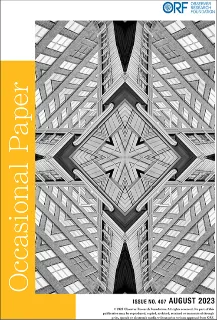







 PREV
PREV



